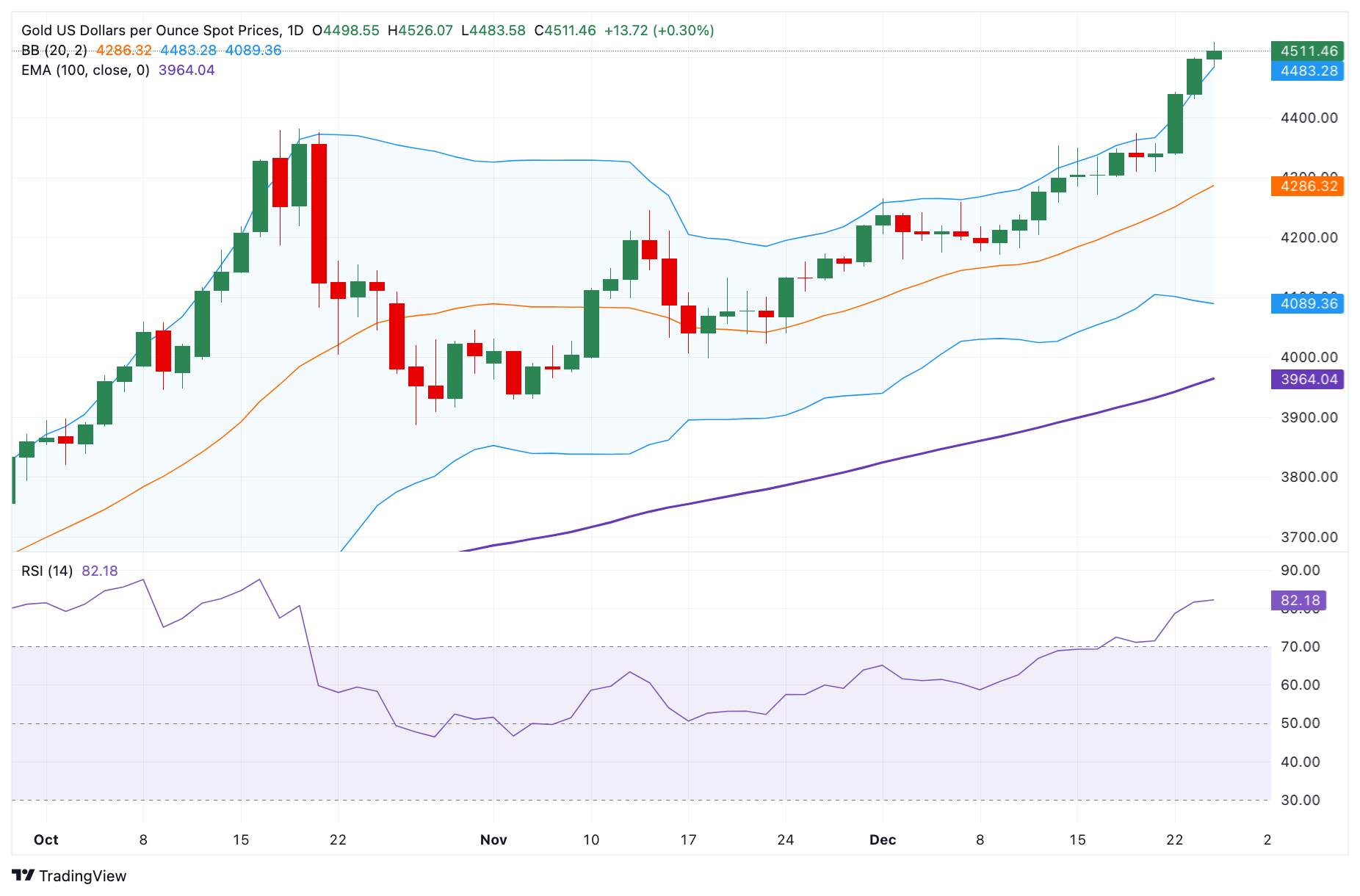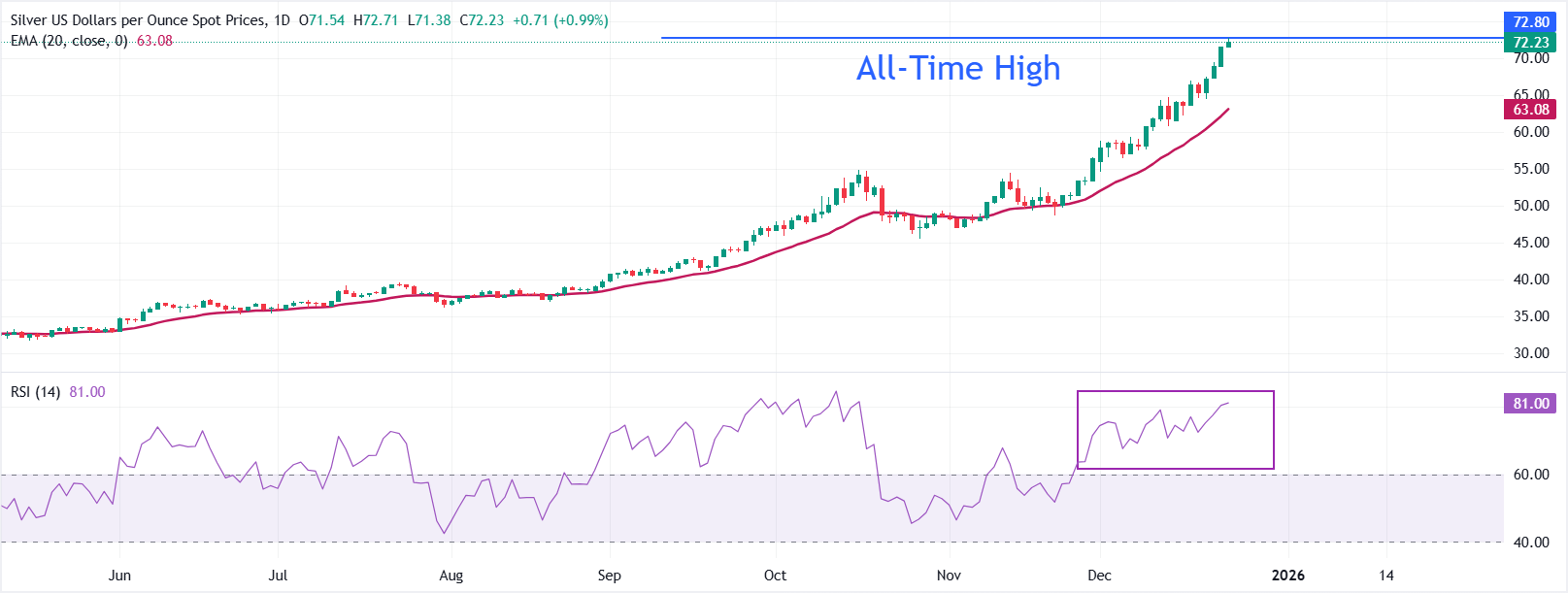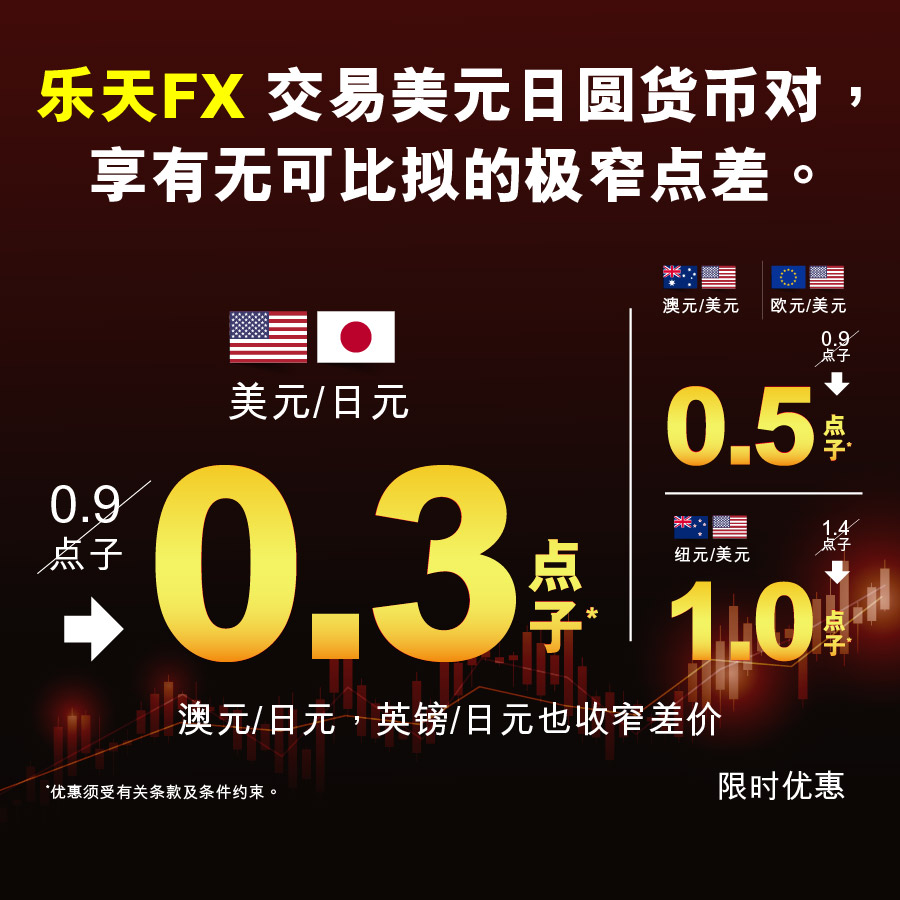Forex News

- Dow Jones futures lose after the S&P 500 ended Tuesday at a new record high.
- Technology stocks once again led the advance, with Nvidia up 3%, Broadcom gaining 2.3%, and Amazon rising 1.6%.
- Traders expect the Fed to deliver two rate cuts in 2026 despite stronger-than-expected US economic data.
Dow Jones futures decline 0.11% to trade near 48,700 during the European session on Wednesday, while S&P 500 and Nasdaq 100 futures also decline, edging lower 0.10% and 0.09% to below 7,000 and 25,800, respectively. The New York Stock Exchange will close early for Christmas Eve and remain closed on Thursday for Christmas Day.
US Index futures edged lower after the S&P 500 closed at a fresh record of 6,909.79 on Tuesday, extending its winning streak to four consecutive sessions. Technology stocks led gains again, with Nvidia rising 3%, Broadcom up 2.3%, and Amazon gaining 1.6%.
Traders continued to price in two Federal Reserve (Fed) rate cuts in 2026 despite stronger-than-expected economic data. Preliminary US annualized GDP grew 4.3% in the July–September period, beating expectations of 3.3% and the prior quarter’s 3.8% expansion. Meanwhile, the core PCE Price Index rose 2.9% quarter-over-quarter, in line with forecasts.
White House Adviser Kevin Hassett said on Tuesday that the Fed is not cutting interest rates quickly enough, even though the US economy grew at a much faster-than-expected pace in the third quarter, according to a CNBC report. Moreover, Fed Member of the Board of Governors Stephen Miran said on Monday that failing to ease policy would raise recession risks, adding that the need to dissent for 50 basis points diminishes over time as rates are reduced.
Dow Jones FAQs
The Dow Jones Industrial Average, one of the oldest stock market indices in the world, is compiled of the 30 most traded stocks in the US. The index is price-weighted rather than weighted by capitalization. It is calculated by summing the prices of the constituent stocks and dividing them by a factor, currently 0.152. The index was founded by Charles Dow, who also founded the Wall Street Journal. In later years it has been criticized for not being broadly representative enough because it only tracks 30 conglomerates, unlike broader indices such as the S&P 500.
Many different factors drive the Dow Jones Industrial Average (DJIA). The aggregate performance of the component companies revealed in quarterly company earnings reports is the main one. US and global macroeconomic data also contributes as it impacts on investor sentiment. The level of interest rates, set by the Federal Reserve (Fed), also influences the DJIA as it affects the cost of credit, on which many corporations are heavily reliant. Therefore, inflation can be a major driver as well as other metrics which impact the Fed decisions.
Dow Theory is a method for identifying the primary trend of the stock market developed by Charles Dow. A key step is to compare the direction of the Dow Jones Industrial Average (DJIA) and the Dow Jones Transportation Average (DJTA) and only follow trends where both are moving in the same direction. Volume is a confirmatory criteria. The theory uses elements of peak and trough analysis. Dow’s theory posits three trend phases: accumulation, when smart money starts buying or selling; public participation, when the wider public joins in; and distribution, when the smart money exits.
There are a number of ways to trade the DJIA. One is to use ETFs which allow investors to trade the DJIA as a single security, rather than having to buy shares in all 30 constituent companies. A leading example is the SPDR Dow Jones Industrial Average ETF (DIA). DJIA futures contracts enable traders to speculate on the future value of the index and Options provide the right, but not the obligation, to buy or sell the index at a predetermined price in the future. Mutual funds enable investors to buy a share of a diversified portfolio of DJIA stocks thus providing exposure to the overall index.

- WTI trades with a positive bias for the fourth straight day amid a combination of supporting factors.
- Rising geopolitical tensions and a broadly weaker USD continue to act as a tailwind for the commodity.
- The mixed technical setup warrants some caution before positioning for a further appreciating move.
West Texas Intermediate (WTI) US Crude Oil prices touch a nearly two-week high, around the $58.55 region on Wednesday, and look to build on the recent recovery from the lowest level since May, touched last week. The upbeat US economic growth figures released on Tuesday, along with the risk of disruptions to oil supply from Venezuela and Russia, continue to act as a tailwind for the commodity.
Meanwhile, bets for further policy easing by the US Federal Reserve (Fed) and concerns about the central bank's independence, amid the growing pressure from US President Donald Trump to cut rates further, continue to weigh on the US Dollar (USD. In fact, the USD Index (DXY) slides to a fresh low since early October and benefits the USD-denominated commodities, including Crude Oil prices.
The commodity remains below the descending 50-day Exponential Moving Average (EMA), pegged around the $59.00 mark, which might cap the upside. The EMA continues to edge lower, keeping the broader tone soft. Measured from the $62.37 high to the $54.83 low, the 50% Fibonacci retracement at $58.60 acts as an immediate hurdle, with the 61.8% at $59.49 next on strength. A daily close above the first barrier could shift the short-term tone and expose the subsequent resistance.
Meanwhile, the Moving Average Convergence Divergence (MACD) histogram has turned positive and is expanding, indicating the MACD line has crossed above the signal line near the zero mark. This shift suggests strengthening bullish momentum after weeks of hesitation. The RSI at 51.80 stands neutral and edges higher, reinforcing an improving tone. If momentum builds, bulls could challenge overhead barriers, while failure to reclaim the average would keep recovery attempts shallow.
(The technical analysis of this story was written with the help of an AI tool)
WTI daily chart
WTI Oil FAQs
WTI Oil is a type of Crude Oil sold on international markets. The WTI stands for West Texas Intermediate, one of three major types including Brent and Dubai Crude. WTI is also referred to as “light” and “sweet” because of its relatively low gravity and sulfur content respectively. It is considered a high quality Oil that is easily refined. It is sourced in the United States and distributed via the Cushing hub, which is considered “The Pipeline Crossroads of the World”. It is a benchmark for the Oil market and WTI price is frequently quoted in the media.
Like all assets, supply and demand are the key drivers of WTI Oil price. As such, global growth can be a driver of increased demand and vice versa for weak global growth. Political instability, wars, and sanctions can disrupt supply and impact prices. The decisions of OPEC, a group of major Oil-producing countries, is another key driver of price. The value of the US Dollar influences the price of WTI Crude Oil, since Oil is predominantly traded in US Dollars, thus a weaker US Dollar can make Oil more affordable and vice versa.
The weekly Oil inventory reports published by the American Petroleum Institute (API) and the Energy Information Agency (EIA) impact the price of WTI Oil. Changes in inventories reflect fluctuating supply and demand. If the data shows a drop in inventories it can indicate increased demand, pushing up Oil price. Higher inventories can reflect increased supply, pushing down prices. API’s report is published every Tuesday and EIA’s the day after. Their results are usually similar, falling within 1% of each other 75% of the time. The EIA data is considered more reliable, since it is a government agency.
OPEC (Organization of the Petroleum Exporting Countries) is a group of 12 Oil-producing nations who collectively decide production quotas for member countries at twice-yearly meetings. Their decisions often impact WTI Oil prices. When OPEC decides to lower quotas, it can tighten supply, pushing up Oil prices. When OPEC increases production, it has the opposite effect. OPEC+ refers to an expanded group that includes ten extra non-OPEC members, the most notable of which is Russia.

- USD/CAD recorded a fresh five-month low of 1.3675 on Wednesday.
- The 14-day Relative Strength Index stands at 26.38, firmly in oversold territory, reinforcing bearish momentum.
- The primary barrier lies at the nine-day EMA of 1.3754.
USD/CAD loses ground for the third consecutive day, trading around 1.3680 during the early European hours on Wednesday. The daily chart suggests a potential upside breakout, with falling, converging trendlines forming a bullish descending wedge pattern.
The USD/CAD pair holds beneath the descending nine-day Exponential Moving Average (EMA) and the 50-day EMA, maintaining a bearish bias. The bearish alignment persists as the nine-day EMA remains below the 50-day EMA and both slopes lower.
The 14-day Relative Strength Index (RSI) at 26.38 sits in oversold territory and continues to decline, confirming downside momentum. RSI below 30 warns of stretched conditions, but momentum stays with sellers unless price stabilizes above the short-term gauge.
The USD/CAD pair reaches fresh five-month low of 1.3675 on December 24, followed by the lower boundary of the descending wedge around 1.3650. A break below the wedge pattern would reinforce the bearish bias and put downward pressure on the pair to navigate the region around 1.3539, the lowest level since October 2024.
On the upside, the USD/CAD pair may rebound toward the nine-day EMA at 1.3754, aligned with the upper descending wedge boundary around 1.3760. A break above this confluence resistance zone could trigger a rebound and support the pair to target the 50-day EMA at 1.3894. Further barrier lies at the three-week high of 1.4014.

Canadian Dollar Price Today
The table below shows the percentage change of Canadian Dollar (CAD) against listed major currencies today. Canadian Dollar was the strongest against the US Dollar.
| USD | EUR | GBP | JPY | CAD | AUD | NZD | CHF | |
|---|---|---|---|---|---|---|---|---|
| USD | -0.03% | -0.12% | -0.33% | -0.10% | -0.24% | -0.08% | -0.09% | |
| EUR | 0.03% | -0.10% | -0.31% | -0.07% | -0.20% | -0.06% | -0.07% | |
| GBP | 0.12% | 0.10% | -0.21% | 0.02% | -0.11% | 0.04% | 0.03% | |
| JPY | 0.33% | 0.31% | 0.21% | 0.23% | 0.11% | 0.25% | 0.25% | |
| CAD | 0.10% | 0.07% | -0.02% | -0.23% | -0.16% | -0.02% | -0.01% | |
| AUD | 0.24% | 0.20% | 0.11% | -0.11% | 0.16% | 0.15% | 0.11% | |
| NZD | 0.08% | 0.06% | -0.04% | -0.25% | 0.02% | -0.15% | -0.01% | |
| CHF | 0.09% | 0.07% | -0.03% | -0.25% | 0.00% | -0.11% | 0.00% |
The heat map shows percentage changes of major currencies against each other. The base currency is picked from the left column, while the quote currency is picked from the top row. For example, if you pick the Canadian Dollar from the left column and move along the horizontal line to the US Dollar, the percentage change displayed in the box will represent CAD (base)/USD (quote).
(The technical analysis of this story was written with the help of an AI tool.)

- The Japanese Yen scales higher against a weaker USD for the third straight day on Wednesday.
- The hawkish BoJ Minutes, along with geopolitical uncertainties, underpin the safe-haven JPY.
- Rising Fed rate cut bets weigh on the USD and exert additional pressure on the USD/JPY pair.
The Japanese Yen (JPY) prolongs its uptrend against a broadly weaker US Dollar (USD) for the third successive day and sticks to gains near the weekly top through the early European session on Wednesday. Minutes of the Bank of Japan's (BoJ) October meeting showed that board members debated the need to continue raising interest rates. Apart from this, geopolitical uncertainties stemming from rising US-Venezuela tensions, the protracted Russia-Ukraine war, and the risk of a renewed Israel-Iran conflict contribute to safe-haven JPY's outperformance.
Meanwhile, the BoJ's hawkish outlook marks a significant divergence compared to rising bets for further policy easing by the US Federal Reserve (Fed). The latter drags the US Dollar (USD) to its lowest level since early October and assists the lower-yielding JPY to reverse last Friday's post-BoJ downfall. However, the upbeat market mood limits further gains for the JPY, though the fundamental backdrop seems tilted firmly in favor of the JPY bulls. This, in turn, backs the case for further depreciation of the USD/JPY pair amid the year-end thin liquidity conditions.
Japanese Yen bulls have the upper hand amid BoJ-Fed policy divergence
- Minutes of the Bank of Japan's October meeting, released earlier this Wednesday, showed that board members agreed that the central bank will continue raising interest rates if economic price forecasts materialize. At the subsequent meeting in December, the central bank raised the policy rate to 0.75%, or a 30-year high, and left the door open to further tightening.
- Moreover, tensions linked to the United States' actions against vessels carrying Venezuelan oil, along with Russia's escalation of attacks on Ukraine and a potential new Israel-Iran war, underpin the safe-haven Japanese Yen for the third consecutive day. Apart from this, the prevalent US Dollar selling bias drags the USD/JPY pair to a fresh weekly low on Wednesday.
- The USD Index (DXY), which tracks the Greenback against a basket of currencies, has declined to a fresh low since early October amid rising bets for two more rate cuts by the Federal Reserve in 2026. Moreover, US President Donald Trump declared that the candidate for the role of the Fed Chair must commit to lowering rates even when the economy is performing well.
- This overshadows Tuesday's upbeat US GDP growth figures, which showed that the economy expanded at a 4.3% annualized pace during the July–September period. The reading was stronger than consensus estimates and the 3.8% rise recorded in the previous quarter, though it does little to provide any respite to the USD bulls or help ease the prevalent selling bias.
- Separately, the US Census Bureau reported that Durable Goods Orders declined 2.2% in October, following the 0.7% increase recorded in the previous month and worse than the market expectation for a decrease of 1.5%. Furthermore, a sharp fall in consumer confidence in December suggested that households are becoming much more cautious about the future.
- Traders now look forward to Wednesday's release of the US Initial Weekly Jobless Claims, which might influence the USD and provide some impetus to the USD/JPY pair later during the North American session. The focus, however, will remain glued to Friday's release of the Tokyo CPI report, which could play a key role in driving the JPY demand in the near term.
USD/JPY technical setup backs the case for an extension of the weekly downtrend
The USD/JPY pair has now reversed the post-BoJ strong move up back closer to the November swing high. Moreover, the weekly downtrend from the vicinity of the 158.00 mark constitutes the formation of a bearish double-top pattern and validates the negative outlook for spot prices.
Meanwhile, the Moving Average Convergence Divergence (MACD) line sits below the Signal line just under the zero mark, while a slightly deeper negative histogram hints at building bearish momentum. The RSI stands at 50 (neutral) after easing from recent highs, reinforcing a wait-and-see stance.
This, in turn, suggests that the USD/JPY pair's downfall could stall near the 155.00 psychological mark. This is followed by the 154.55-154.50 horizontal zone, which should act as the neckline support of the bearish pattern. A convincing break below will be seen as a key trigger for bearish traders and pave the way for deeper losses.
(The technical analysis of this story was written with the help of an AI tool)
Japanese Yen Price This week
The table below shows the percentage change of Japanese Yen (JPY) against listed major currencies this week. Japanese Yen was the strongest against the US Dollar.
| USD | EUR | GBP | JPY | CAD | AUD | NZD | CHF | |
|---|---|---|---|---|---|---|---|---|
| USD | -0.67% | -0.97% | -1.23% | -0.82% | -1.55% | -1.74% | -0.96% | |
| EUR | 0.67% | -0.29% | -0.59% | -0.16% | -0.88% | -1.08% | -0.28% | |
| GBP | 0.97% | 0.29% | -0.19% | 0.13% | -0.59% | -0.79% | 0.02% | |
| JPY | 1.23% | 0.59% | 0.19% | 0.44% | -0.27% | -0.47% | 0.19% | |
| CAD | 0.82% | 0.16% | -0.13% | -0.44% | -0.65% | -0.91% | -0.12% | |
| AUD | 1.55% | 0.88% | 0.59% | 0.27% | 0.65% | 0.10% | 0.61% | |
| NZD | 1.74% | 1.08% | 0.79% | 0.47% | 0.91% | -0.10% | 0.81% | |
| CHF | 0.96% | 0.28% | -0.02% | -0.19% | 0.12% | -0.61% | -0.81% |
The heat map shows percentage changes of major currencies against each other. The base currency is picked from the left column, while the quote currency is picked from the top row. For example, if you pick the Japanese Yen from the left column and move along the horizontal line to the US Dollar, the percentage change displayed in the box will represent JPY (base)/USD (quote).

- NZD/USD drifts higher to around 0.5845 in Wednesday’s early European session.
- Growing expectations of a US rate cut and concerns over Fed independence weigh on the US Dollar.
- The risk-off mood and safe-haven flows might cap the upside for the pair.
The NZD/USD pair extends its upside to near 0.5845 during the early European session on Wednesday. The US Dollar (USD) weakens against the New Zealand Dollar (NZD) on the prospect of a further interest rate cut by the US Federal Reserve (Fed). The weekly US Initial Jobless Claims data will be published later in the day.
Data released by the Bureau of Economic Analysis on Tuesday indicated that strong growth in the world's largest economy failed to shift sentiment from expectations of Fed interest rate reductions next year. The US economy expanded at a 4.3% annualized pace in the third quarter (Q3). This figure was stronger than the estimates of 3.3% and followed 3.8% growth in Q2.
US President Donald Trump said on Tuesday that he expects his Fed Chair to lower interest rates if the economy is doing well. Trump noted that the next Fed chair will be someone who believes in lower interest rates "by a lot”. He indicated that disagreement with his views would disqualify candidates from consideration for the Fed’s top job. His comments are likely to heighten concerns among investors and policymakers about Fed independence, which could drag the Greenback lower and create a tailwind for the pair.
Nonetheless, the risk-off sentiment amid uncertainty and rising geopolitical tensions could boost the safe-haven currency, such as the USD. The US intensified its attempts to block Venezuela's crude oil supplies. In an effort to disrupt supply and cut off funding for the Maduro regime, the US intercepted two Venezuelan oil tankers in the Caribbean Sea and threatened to seize additional sanctioned boats approaching or departing Venezuela.
New Zealand Dollar FAQs
The New Zealand Dollar (NZD), also known as the Kiwi, is a well-known traded currency among investors. Its value is broadly determined by the health of the New Zealand economy and the country’s central bank policy. Still, there are some unique particularities that also can make NZD move. The performance of the Chinese economy tends to move the Kiwi because China is New Zealand’s biggest trading partner. Bad news for the Chinese economy likely means less New Zealand exports to the country, hitting the economy and thus its currency. Another factor moving NZD is dairy prices as the dairy industry is New Zealand’s main export. High dairy prices boost export income, contributing positively to the economy and thus to the NZD.
The Reserve Bank of New Zealand (RBNZ) aims to achieve and maintain an inflation rate between 1% and 3% over the medium term, with a focus to keep it near the 2% mid-point. To this end, the bank sets an appropriate level of interest rates. When inflation is too high, the RBNZ will increase interest rates to cool the economy, but the move will also make bond yields higher, increasing investors’ appeal to invest in the country and thus boosting NZD. On the contrary, lower interest rates tend to weaken NZD. The so-called rate differential, or how rates in New Zealand are or are expected to be compared to the ones set by the US Federal Reserve, can also play a key role in moving the NZD/USD pair.
Macroeconomic data releases in New Zealand are key to assess the state of the economy and can impact the New Zealand Dollar’s (NZD) valuation. A strong economy, based on high economic growth, low unemployment and high confidence is good for NZD. High economic growth attracts foreign investment and may encourage the Reserve Bank of New Zealand to increase interest rates, if this economic strength comes together with elevated inflation. Conversely, if economic data is weak, NZD is likely to depreciate.
The New Zealand Dollar (NZD) tends to strengthen during risk-on periods, or when investors perceive that broader market risks are low and are optimistic about growth. This tends to lead to a more favorable outlook for commodities and so-called ‘commodity currencies’ such as the Kiwi. Conversely, NZD tends to weaken at times of market turbulence or economic uncertainty as investors tend to sell higher-risk assets and flee to the more-stable safe havens.

Here is what you need to know on Wednesday, December 24:
The action in financial markets turns subdued on Wednesday as participants get ready for the Christmas holiday. Stock and bond markets in the US will open at the usual time but will close early on Christmas Eve, and the economic calendar will not feature any high-tier data releases until next week.
US Dollar Price This week
The table below shows the percentage change of US Dollar (USD) against listed major currencies this week. US Dollar was the weakest against the New Zealand Dollar.
| USD | EUR | GBP | JPY | CAD | AUD | NZD | CHF | |
|---|---|---|---|---|---|---|---|---|
| USD | -0.70% | -1.01% | -1.26% | -0.85% | -1.57% | -1.77% | -0.98% | |
| EUR | 0.70% | -0.30% | -0.59% | -0.15% | -0.87% | -1.07% | -0.28% | |
| GBP | 1.01% | 0.30% | -0.19% | 0.15% | -0.58% | -0.77% | 0.02% | |
| JPY | 1.26% | 0.59% | 0.19% | 0.43% | -0.26% | -0.45% | 0.20% | |
| CAD | 0.85% | 0.15% | -0.15% | -0.43% | -0.65% | -0.92% | -0.13% | |
| AUD | 1.57% | 0.87% | 0.58% | 0.26% | 0.65% | 0.10% | 0.60% | |
| NZD | 1.77% | 1.07% | 0.77% | 0.45% | 0.92% | -0.10% | 0.80% | |
| CHF | 0.98% | 0.28% | -0.02% | -0.20% | 0.13% | -0.60% | -0.80% |
The heat map shows percentage changes of major currencies against each other. The base currency is picked from the left column, while the quote currency is picked from the top row. For example, if you pick the US Dollar from the left column and move along the horizontal line to the Japanese Yen, the percentage change displayed in the box will represent USD (base)/JPY (quote).
The US Bureau of Economic Analysis (BEA) reported on Tuesday that the US' Gross Domestic Product (GDP) expanded at an annual rate of 4.3% in the third quarter. This print followed the 3.8% expansion recorded in the second quarter and came in much better than the market expectation of 3.3%. Other data from the US showed that Durable Goods Orders contracted by 2.2% on a monthly basis in October, while Industrial Production expanded by 0.2% in November. Although the US Dollar (USD) Index recovered from daily lows with the immediate reaction to the upbeat GDP data, it failed to extend its rebound later in the American session. The USD Index is down about 1% since the beginning of the week and stays quiet below 98.00 in the European morning.
Meanwhile, US President Donald Trump said in a social media post on Tuesday that anybody who disagrees with him will never be the chairman for the Federal Reserve, adding that he wants the new chairman to lower interest rates if the market is doing well. US stock index futures trade marginally lower early Wednesday after Wall Street's main indexes registered small gains on Tuesday.
Gold extended its weekly rally during the Asian trading hours and hit a new record-high above $4,520 before retreating below $4,500 by the European morning. Gold is up 3.5% this week and remains on track to end the fifth consecutive month in positive territory.
EUR/USD stays in a consolidation phase in the early European session after climbing above 1.1800 and setting a three-month-high.
GBP/USD is up 1% this week after posting strong gains on Monday and Tuesday. The pair holds steady above 1.3500 to start the European session.
USD/JPY remains under bearish pressure for the third consecutive day on Wednesday and declines toward 155.50.
Fed FAQs
Monetary policy in the US is shaped by the Federal Reserve (Fed). The Fed has two mandates: to achieve price stability and foster full employment. Its primary tool to achieve these goals is by adjusting interest rates. When prices are rising too quickly and inflation is above the Fed’s 2% target, it raises interest rates, increasing borrowing costs throughout the economy. This results in a stronger US Dollar (USD) as it makes the US a more attractive place for international investors to park their money. When inflation falls below 2% or the Unemployment Rate is too high, the Fed may lower interest rates to encourage borrowing, which weighs on the Greenback.
The Federal Reserve (Fed) holds eight policy meetings a year, where the Federal Open Market Committee (FOMC) assesses economic conditions and makes monetary policy decisions. The FOMC is attended by twelve Fed officials – the seven members of the Board of Governors, the president of the Federal Reserve Bank of New York, and four of the remaining eleven regional Reserve Bank presidents, who serve one-year terms on a rotating basis.
In extreme situations, the Federal Reserve may resort to a policy named Quantitative Easing (QE). QE is the process by which the Fed substantially increases the flow of credit in a stuck financial system. It is a non-standard policy measure used during crises or when inflation is extremely low. It was the Fed’s weapon of choice during the Great Financial Crisis in 2008. It involves the Fed printing more Dollars and using them to buy high grade bonds from financial institutions. QE usually weakens the US Dollar.
Quantitative tightening (QT) is the reverse process of QE, whereby the Federal Reserve stops buying bonds from financial institutions and does not reinvest the principal from the bonds it holds maturing, to purchase new bonds. It is usually positive for the value of the US Dollar.

- Gold price pulls back from all-time high in Wednesday’s early European session.
- The stronger-than-expected US GDP report and profit-taking weigh on the Gold price.
- Fed rate cut bets and safe-haven flows might cap the downside for XAU/USD.
Gold price (XAU/USD) eases from a record high of $4,526 during the early European trading hours on Wednesday as traders book some profits. Additionally, the upbeat US Gross Domestic Product (GDP) data might also weigh on the Gold price. It’s worth noting that strong GDP often boosts the US Dollar (USD), making Gold more expensive for non-US buyers, pressuring prices.
Nonetheless, the potential downside for the yellow metal might be limited as persistent geopolitical uncertainty, particularly in the US-Venezuela conflict, might keep safe-haven demand elevated.
Growing expectations of further US Federal Reserve (Fed) rate cuts next year could boost the Gold price. Financial markets are pricing in multiple Fed interest rate reductions in 2026 amid signs of easing inflation and sluggish jobs growth. Lower interest rates could reduce the opportunity cost of holding Gold, supporting the non-yielding precious metal.
Financial markets are likely to remain subdued ahead of the Christmas holiday. Traders await the release of the US Initial Jobless Claims data later on Wednesday for fresh impetus. The market consensus was for 223,000 initial jobless claims for the week ending December 13, compared to 224,000 in the previous reading.
Daily Digest Market Movers: Gold corrects from record high despite Venezuela tensions
- Venezuela’s parliament on Tuesday approved a measure that criminalizes a broad range of activities that can hinder navigation and commerce in the South American country, such as the seizure of oil tankers. The law, which includes "other international crimes," comes after recent US actions against Venezuelan oil shipments.
- The US Gross Domestic Product (GDP) grew at a 4.3% annualized pace in the third quarter (Q3), according to the Bureau of Economic Analysis on Tuesday. This figure came in stronger than the expectation of 3.3% and followed 3.8% growth in Q2.
- The Conference Board's Consumer Confidence Index declined to 89.1 in December from 92.9 in November.
US President Donald Trump said on Tuesday that he expects his Fed Chair to lower interest rates if the economy is doing well. - Trump noted that the next Fed chair will be someone who believes in lower interest rates "by a lot”. He indicated that disagreement with his views would disqualify candidates from consideration for the Fed’s top job. The comments are likely to heighten concerns among investors and policymakers about Federal Reserve independence.
- White House Adviser Kevin Hassett said that the Fed is not cutting interest rates quickly enough, even though the US economy grew at a much faster-than-expected pace in the third quarter, per CNBC.
Gold continues its bullish trajectory, overbought RSI warrants caution for bulls
Gold loses momentum on the day. However, in the longer term, the path of least resistance is to the upside as the yellow metal is well-supported above the key 100-day Exponential Moving Average (EMA) on the daily chart. The Bollinger Bands widen, suggesting strong trend continuation.
Despite the bullish trend, the 14-day Relative Strength Index (RSI) is located above 70, indicating an overbought condition. This suggests that any upside extension could be tempered by a period of digestion before the next leg higher.
Green candlesticks and sustained trading above the $4,500 psychological mark could make another run toward $4,550, en route to a round figure of $4,600.
On the flip side, the first downside target for Gold is seen at the December 22 low of $4,338. Any follow-through selling below the mentioned level could expose the December 17 low of $4,300.

Gold FAQs
Gold has played a key role in human’s history as it has been widely used as a store of value and medium of exchange. Currently, apart from its shine and usage for jewelry, the precious metal is widely seen as a safe-haven asset, meaning that it is considered a good investment during turbulent times. Gold is also widely seen as a hedge against inflation and against depreciating currencies as it doesn’t rely on any specific issuer or government.
Central banks are the biggest Gold holders. In their aim to support their currencies in turbulent times, central banks tend to diversify their reserves and buy Gold to improve the perceived strength of the economy and the currency. High Gold reserves can be a source of trust for a country’s solvency. Central banks added 1,136 tonnes of Gold worth around $70 billion to their reserves in 2022, according to data from the World Gold Council. This is the highest yearly purchase since records began. Central banks from emerging economies such as China, India and Turkey are quickly increasing their Gold reserves.
Gold has an inverse correlation with the US Dollar and US Treasuries, which are both major reserve and safe-haven assets. When the Dollar depreciates, Gold tends to rise, enabling investors and central banks to diversify their assets in turbulent times. Gold is also inversely correlated with risk assets. A rally in the stock market tends to weaken Gold price, while sell-offs in riskier markets tend to favor the precious metal.
The price can move due to a wide range of factors. Geopolitical instability or fears of a deep recession can quickly make Gold price escalate due to its safe-haven status. As a yield-less asset, Gold tends to rise with lower interest rates, while higher cost of money usually weighs down on the yellow metal. Still, most moves depend on how the US Dollar (USD) behaves as the asset is priced in dollars (XAU/USD). A strong Dollar tends to keep the price of Gold controlled, whereas a weaker Dollar is likely to push Gold prices up.

- EUR/GBP softens to near 0.8725 in Wednesday’s early European session.
- The BoE’s cautious stance, which signaled that the pace of future cuts may slow, boosts the Pound Sterling.
- Declining expectations that the ECB will cut interest rates in February 2026 might cap the downside for the cross.
The EUR/GBP cross trades in negative territory for the fifth consecutive day around 0.8725 during the early European session on Wednesday. The Pound Sterling (GBP) edges higher against the Euro (EUR) after the Bank of England (BoE) delivered a widely anticipated rate cut while indicating that the bar for further reduction was high due to persistent inflation.
The BoE’s Monetary Policy Committee decided to cut a quarter point in its benchmark interest rate to 3.75% last week, the first cut since last August. Governor Andrew Bailey said during the press conference that rates are likely to continue on a gradual downward path, but "how much further we go becomes a closer call" with each cut.
Money markets believe the BoE will deliver at least one rate cut in the first half of the year and are pricing in nearly a 50% probability of a second before the year-end, according to Reuters. Expectations that the UK central bank will follow a gradual monetary easing path in 2026 could provide some support to the GBP and act as a headwind for the cross in the near term.
The European Central Bank (ECB) left its three key interest rates unchanged at its December policy meeting. The decision was unanimous and marks the fourth consecutive meeting where rates have been held steady. ECB President Christine Lagarde said the bank remains in a “good position” and emphasized that there is consensus within the Governing Council to keep all options open, including the possibility of raising rates if necessary.
The money markets have priced in a 25-basis-point interest rate cut by the ECB in February 2026 and currently remain below 10%. Signals that the ECB rate cut cycle is ending might help limit the EUR’s losses.
Pound Sterling FAQs
The Pound Sterling (GBP) is the oldest currency in the world (886 AD) and the official currency of the United Kingdom. It is the fourth most traded unit for foreign exchange (FX) in the world, accounting for 12% of all transactions, averaging $630 billion a day, according to 2022 data. Its key trading pairs are GBP/USD, also known as ‘Cable’, which accounts for 11% of FX, GBP/JPY, or the ‘Dragon’ as it is known by traders (3%), and EUR/GBP (2%). The Pound Sterling is issued by the Bank of England (BoE).
The single most important factor influencing the value of the Pound Sterling is monetary policy decided by the Bank of England. The BoE bases its decisions on whether it has achieved its primary goal of “price stability” – a steady inflation rate of around 2%. Its primary tool for achieving this is the adjustment of interest rates. When inflation is too high, the BoE will try to rein it in by raising interest rates, making it more expensive for people and businesses to access credit. This is generally positive for GBP, as higher interest rates make the UK a more attractive place for global investors to park their money. When inflation falls too low it is a sign economic growth is slowing. In this scenario, the BoE will consider lowering interest rates to cheapen credit so businesses will borrow more to invest in growth-generating projects.
Data releases gauge the health of the economy and can impact the value of the Pound Sterling. Indicators such as GDP, Manufacturing and Services PMIs, and employment can all influence the direction of the GBP. A strong economy is good for Sterling. Not only does it attract more foreign investment but it may encourage the BoE to put up interest rates, which will directly strengthen GBP. Otherwise, if economic data is weak, the Pound Sterling is likely to fall.
Another significant data release for the Pound Sterling is the Trade Balance. This indicator measures the difference between what a country earns from its exports and what it spends on imports over a given period. If a country produces highly sought-after exports, its currency will benefit purely from the extra demand created from foreign buyers seeking to purchase these goods. Therefore, a positive net Trade Balance strengthens a currency and vice versa for a negative balance.

- Silver price extends rally to near $72.70 amid firm Fed dovish expectations for 2026.
- The Fed is expected to cut interest rates by at least 50 bps next year.
- The US Q3 GDP unexpectedly grew by 4.3%, faster than the prior reading of 3.8%.
Silver price (XAG/USD) rallies further to near $72.70 during the early European trading session on Wednesday. The white metal extends its bull run as Federal Reserve (Fed) dovish expectations for 2026 remain broadly firm, even as the United States (US) Q3 Gross Domestic Product (GDP) came in surprisingly higher.
According to the CME FedWatch tool, traders see a 70.6% that the Fed will reduce interest rates by at least 50 bps in 2026, signaling a higher scope of interest rate cuts than the Fed’s projections in its dot plot last week. The Fed’s dot plot showed that policymakers collectively see the Federal Funds Rate heading to 3.4% by the end of 2026, indicating that there won’t be more than one interest rate cut.
Theoretically, lower interest rates by the Fed bode well for non-yielding assets, such as Silver.
On Tuesday, the US GDP data showed that the economy grew at a robust pace of 4.3% year-on-year (YoY). Economists expect the US GDP growth to come in lower at 3.3% from 3.8% recorded in the second quarter of the year.
In Wednesday’s session, investors will focus on Initial Jobless Claims data, which will be published at 13:30 GMT. Individuals claiming jobless benefits for the first time are expected to have remained steady at 223K.
Silver technical analysis

In the daily chart, XAG/USD trades at $72.19. The 20-day exponential moving average is ascending, and price holds well above it, reinforcing a firm bullish bias. The average’s positive slope continues to support the advance. RSI (14) at 80.95 is overbought, signaling stretched momentum that could precede consolidation.
Should momentum cool, pullbacks could find support at the 20-day EMA around $63.07. The uptrend would remain intact while above this dynamic floor, whereas a loss of that level would expose a deeper retracement as overbought conditions unwind.
(The technical analysis of this story was written with the help of an AI tool.)
Silver FAQs
Silver is a precious metal highly traded among investors. It has been historically used as a store of value and a medium of exchange. Although less popular than Gold, traders may turn to Silver to diversify their investment portfolio, for its intrinsic value or as a potential hedge during high-inflation periods. Investors can buy physical Silver, in coins or in bars, or trade it through vehicles such as Exchange Traded Funds, which track its price on international markets.
Silver prices can move due to a wide range of factors. Geopolitical instability or fears of a deep recession can make Silver price escalate due to its safe-haven status, although to a lesser extent than Gold's. As a yieldless asset, Silver tends to rise with lower interest rates. Its moves also depend on how the US Dollar (USD) behaves as the asset is priced in dollars (XAG/USD). A strong Dollar tends to keep the price of Silver at bay, whereas a weaker Dollar is likely to propel prices up. Other factors such as investment demand, mining supply – Silver is much more abundant than Gold – and recycling rates can also affect prices.
Silver is widely used in industry, particularly in sectors such as electronics or solar energy, as it has one of the highest electric conductivity of all metals – more than Copper and Gold. A surge in demand can increase prices, while a decline tends to lower them. Dynamics in the US, Chinese and Indian economies can also contribute to price swings: for the US and particularly China, their big industrial sectors use Silver in various processes; in India, consumers’ demand for the precious metal for jewellery also plays a key role in setting prices.
Silver prices tend to follow Gold's moves. When Gold prices rise, Silver typically follows suit, as their status as safe-haven assets is similar. The Gold/Silver ratio, which shows the number of ounces of Silver needed to equal the value of one ounce of Gold, may help to determine the relative valuation between both metals. Some investors may consider a high ratio as an indicator that Silver is undervalued, or Gold is overvalued. On the contrary, a low ratio might suggest that Gold is undervalued relative to Silver.

- GBP/JPY remains under some selling pressure for the second straight day on Wednesday.
- BoJ rate hike bets and safe-haven flows benefit the JPY, exerting pressure on the cross.
- The BoE’s hawkish outlook supports the GBP and helps limit the downside for spot prices.
The GBP/JPY cross attracts some sellers for the second straight day on Wednesday and trades around mid-210.00s, closer to the weekly trough during the Asian session. Spot prices, however, remain within striking distance of the highest level since August 2008, touched on Monday. Moreover, the fundamental backdrop warrants some caution before positioning for any meaningful corrective decline.
The Japanese Yen (JPY) gets a minor lift following the release of the Bank of Japan's (BoJ) October policy meeting Minutes, which showed a broad agreement that the central bank should continue raising rates if economic price forecasts materialize. At the subsequent meeting in December, the BoJ raised the policy rate to 0.75%, or a 30 year high, and left the door open to further tightening. This, along with persistent geopolitical uncertainties, benefits the JPY's safe-haven status and exerts some pressure on the GBP/JPY cross.
Meanwhile, the British Pound (GBP) draws support from the Bank of England's (BoE) hawkish rate cut last Thursday. A close 5-4 MPC vote split to lower the benchmark interest rate by 25 basis points (bps) to 3.75% pointed to differences within the committee, especially after last week's inflation surprise. This, in turn, forced investors to scale back their expectations for more aggressive easing next year, which acts as a tailwind for the GBP. Apart from this, a positive risk tone might cap the JPY and support the GBP/JPY cross.
Hence, it will be prudent to wait for strong follow-through selling before confirming that spot prices have topped out in the near term and placing aggressive bearish bets amid the year-end thin trading. Traders now look to BoJ Governor Kazuo Ueda's speech on Thursday for cues about the future policy path. Apart from this, Friday's release of Tokyo CPI, along with other important macro data from Japan, will play a key role in influencing the near-term JPY price dynamics and provide some meaningful impetus to the GBP/JPY cross.
Japanese Yen Price Today
The table below shows the percentage change of Japanese Yen (JPY) against listed major currencies today. Japanese Yen was the strongest against the US Dollar.
| USD | EUR | GBP | JPY | CAD | AUD | NZD | CHF | |
|---|---|---|---|---|---|---|---|---|
| USD | -0.05% | -0.12% | -0.31% | -0.08% | -0.15% | -0.08% | -0.11% | |
| EUR | 0.05% | -0.08% | -0.28% | -0.03% | -0.10% | -0.03% | -0.06% | |
| GBP | 0.12% | 0.08% | -0.21% | 0.04% | -0.03% | 0.05% | 0.03% | |
| JPY | 0.31% | 0.28% | 0.21% | 0.26% | 0.17% | 0.24% | 0.23% | |
| CAD | 0.08% | 0.03% | -0.04% | -0.26% | -0.09% | -0.02% | -0.02% | |
| AUD | 0.15% | 0.10% | 0.03% | -0.17% | 0.09% | 0.07% | 0.02% | |
| NZD | 0.08% | 0.03% | -0.05% | -0.24% | 0.02% | -0.07% | -0.01% | |
| CHF | 0.11% | 0.06% | -0.03% | -0.23% | 0.02% | -0.02% | 0.01% |
The heat map shows percentage changes of major currencies against each other. The base currency is picked from the left column, while the quote currency is picked from the top row. For example, if you pick the Japanese Yen from the left column and move along the horizontal line to the US Dollar, the percentage change displayed in the box will represent JPY (base)/USD (quote).
Forex Market News
Our dedicated focus on forex news and insights empowers you to capitalise on investment opportunities in the dynamic FX market. The forex landscape is ever-evolving, characterised by continuous exchange rate fluctuations shaped by vast influential factors. From economic data releases to geopolitical developments, these events can sway market sentiment and drive substantial movements in currency valuations.
At Rakuten Securities Hong Kong, we prioritise delivering timely and accurate forex news updates sourced from reputable platforms like FXStreet. This ensures you stay informed about crucial market developments, enabling informed decision-making and proactive strategy adjustments. Whether you’re monitoring forex forecasts, analysing trading perspectives, or seeking to capitalise on emerging trends, our comprehensive approach equips you with the insights needed to navigate the FX market effectively.
Stay ahead with our comprehensive forex news coverage, designed to keep you informed and prepared to seize profitable opportunities in the dynamic world of forex trading.








